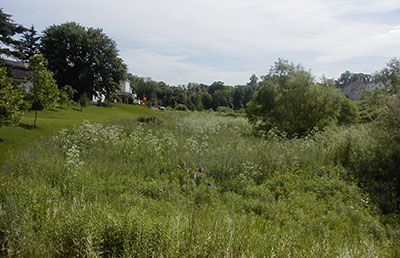Design Elements — Habitat

This trail passes through an area of woodland which, along with a preserved stream, provide extensive habitat area in Kimberton Greene.
Through the protection of contiguous open space and natural resources, conservation subdivisions have the potential to sustain wildlife habitat that existed pre-development and potentially even enhance habitat if designed thoughtfully. In general, the greater number of ecosystem types provided (woodland, wetland, hedgerow, meadow, riparian area, etc.) the greater the site's habitat potential. Ensuring connection to open space and natural resources on adjacent parcels can help maintain wildlife corridors through the property. Providing native food sources, water sources, and places of shelter for wildlife are all integral in the provision of a viable habitat. Having an understanding of the existing wildlife is important to designing for the proper habitat conditions.

The rolling meadows and extensive riparian buffer provide over 80 acres of potential habitat area in Brandywine at Thornbbury.
Ordinance Considerations
Ordinances should provide adequate protection for existing natural features, including riparian buffers, wetlands, steep slopes, woodlands, and wetlands. These ordinances should apply to all development, not just conservation subdivisions. Conservation subdivision developments should be required to maintain greenway corridors that connect adjacent properties to the extent possible. Ordinances should also require developments to use native plants within naturalized areas, as they serve the habitat needs of local fauna better than introduced/exotic species. Invasive species should never be permitted.
Good Examples

The hillside adjacent to the dwelling units at Charlestown Hunt is part of the development's open space and provides valuable habitat for a wide variety of species

